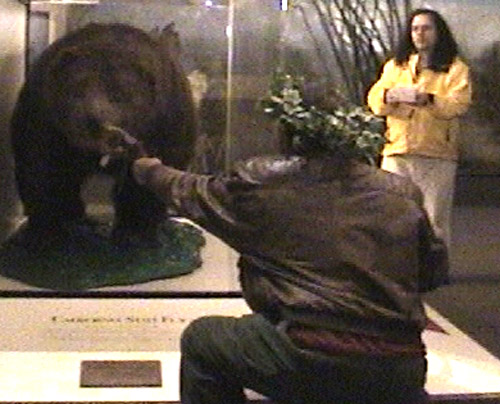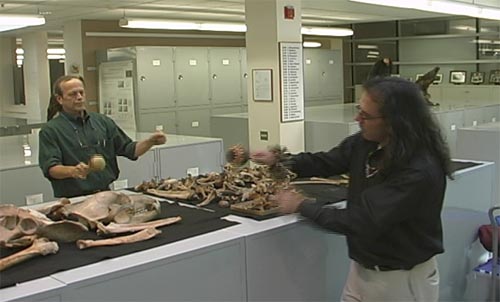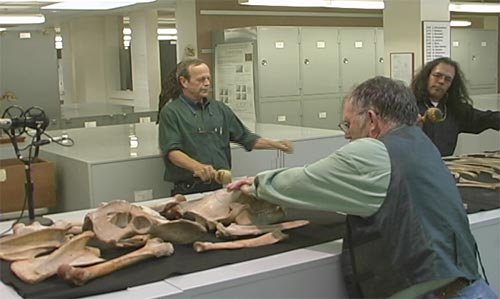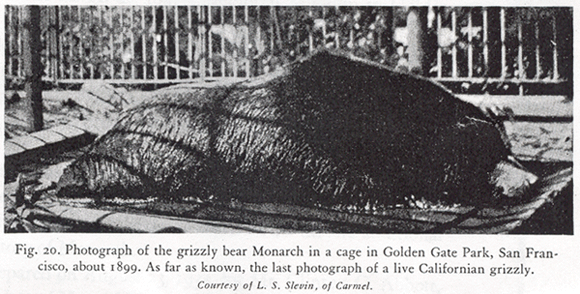|
History and Ritual Honoring of the Monarch Bear
The Monarch Bear was killed in May of 1911, in order to put him out of the great misery he was living in with arthritis and old age. His pelt, skull, and feet were stuffed by a taxidermist and placed on exhibit in the Academy of Sciences in Golden Gate park at that time. The rest of his body was buried in Golden Gate Park. Subsequently, after six months of negotiations the Museum of Vertebrate Zoology, at UC Berkeley, was successfully granted the bear's remains by Golden Gate Park. The bear was ethumed and taken by Museum staff to Berkeley, where he underwent a process of what's called macination, which involves the removal of the flesh from the bones (See below, a hand-written card from the Museum of Vertebrate Zoology describing the above history).
The digging up of the Monarch Bear's bones and their being placed in cold storage at the Museum of Vertebrate Zoology in order to prevent their deterioration, as well as the bear's pelt, skull, and claws being preserved in a glass cube in the Academy of Sciences are very disturbing and upsetting to any Native Shamanistic traditions. In Native American traditions, Celtic traditions, and other shamanistic traditions, it is held strongly that in order for the soul of a being to be able to leave this world, go to other worlds, be transformed, and re-born, its physical form needs to degenerate materially into its components (i.e. water, minerals, etc.), and be transformed by natural processes into other forms including being absorbed by trees and plants and returning as water into the sky as clouds. It is extremely disturbing from a shamanistic point of view that the Monarch Bear, the totem animal of the state of California, the last wild Grizzly Bear of California, has been denied his rightful journey of transformation and rebirth.
Worlwide in the Northern Hemisphere, the BEAR has had for at least fifteen thousand years, a special place in human culture and spirituality. There are various bear mythologies, but they all involve a close relationship between bears and humans sharing ancestors. A common mythos involves a god-like bear descending from the stars, marrying a human princess, and fathering a line of human/bear heroes, who bring culture and strength to humanity. Other mythos involves a great bear mother who mates with a human warrior and gives birth to a line of human/bear heroes. The Yurok tribes of Northern California mythos concerning the bear focuses upon the belief that the bear was once a human being. The myth involves a young Yurok child who disliked living in a human village, and was fascinated with nature. He ran away to the woods and stayed away longer and longer, and over time he changed into a bear. The Yurok therefore believe that bears are human beings and they therefore avoid killing or eating the bear because they are seen as human beings.
Given that in a majority of Native American cultures, the bear is seen as a tribal ancestor, bears were given special rights honoring them at their death and burial rights similar to human beings. It is the position of Five Shaman Circles, and the Monarch Bear Film project, that one of our primary goals in the film, "Honoring the Monarch Bear" is to facilitate an honorable burial for the Monarch Bear, at some point in the future.
Several years ago, after a good deal of political and legal action by Native Californian people, the brain of Ishi, the last of the Yahi people was liberated from UC medical school's care and given a proper burial in his native land. Synchronistically, Ishi and the Monarch Bear both ended up in San Francisco, and died here around the same time period. It is our position that it is as important that the Monarch Bear receive a proper burial as it was that Ishi received a proper burial. (Click here to read more about Ishi).
We will soon be filming Yurok tribal elders and story tellers sharing the Yurok story of the child who became the bear.
Five Shaman Circles in alliance with Native American Shamans, have begun already the process ritualistically of reclaiming and honoring the spirit and body of the Monarch Bear, state totem animal of California. We performed a ritual upon the winter solstice, 2003, at the Academy of Sciences in Golden Gate Park, with the body of the Monarch Bear. This ritual occurred about a week before the museum closed and was demolished. (It will be rebuilt over the next five years). The ritual involved calling upon the spirit of the Monarch Bear to leave its body and skull and enter into two bear claws, which will be ritualistically buried this summer in the Sierras.

Minister Rodney with the assistance of Mewok Shaman Marro calling the Monarch Bear spirit out from his body, trapped in a glass cube in the Academy of Sciences.

Minister Rodney with the assistance of Mewok Shaman Marro and Cherokee/Irish Shaman Bill placing the spirit of the Monarch Bear into two bear-claws within a bone-box.
Continuing the process of blessing and purification of the Monarch Bear for his burial this summer, minister Rodney with the assistance of Mewok Shaman Marro and Cherokee/Irish Shaman Bill performed a ritual blessing and purification at the Museum of vertebrate zoology, UC Berkeley, upon Friday, April 23, 2004. This ritual blessing was performed over the bones of the Monarch Bear - which reside at the museum. This ritual purification and blessing was performed in order to prepare the Monarch bear spirit and body for its journey of death/rebirth and regeneration.

Ritual purification and blessing of the Monarch Bear's bones at the Museum of Vertebrate Zoology, UC Berkeley, which occurred on Friday, April 23, 2004.

Ritual purification and blessing of the Monarch Bear's bones at the Museum of Vertebrate Zoology, UC Berkeley, which occurred on Friday, April 23, 2004.
The following article from "Fur Bearing Mammals of California", gives a good history of the Monarch Bear, his capture, his life in captivity, his death, and what has occurred with his honorable remains.

According to Allen Kelly (Bears I Have Met - and Others, 1903), the story of the bear Monarch, as published originally in the San Francisco Examiner and copied verbatim by Joaquin Miller in his fanciful book, True Bear Stories (1900), was "elaborated to suit the exigencies of enterprising journalism, picturesque features were introduced where editorial judgment dictated, and mere facts, such as the name of the country in which the bear was caught, fell under the ban of a careless blue pencil and were distorted beyond recognition." According to the Kelly version, Monarch was caught in a log trap "late in October," 1889 by some Mexicans on Mount Gleason, in the San Gabriel Mountains of Los Angeles County (not "Kern County").

Lazy Bear -- the Monarch Bear taking a bath in his bear-pit at Monarch Bear Hill in Golden Gate park - 1889
picture taken from "Fur-bearing Mammals of California", pg. 89
Fig.20. Photograph of the grizzly bear Monarch in a cage in Golden Gate Park, San Francisco, about 1889. As far as known, the last photograph of a live Californian grizzly.
Courtesy of L. S. Stevin, of Carmel.

Kelly, after a fruitless bear hunt of his own in the interests of the Examiner, purchased Monarch from one of the Mexicans and after various adventures delivered it to Woodward's Gardens, San Francisco. It was currently stated to be "the largest bear in captivity and a thoroughbred Californian Grizzly." Eventually, the bear was presented to Golden Gate Park. Its weight was "estimated by the best judges at from 1200 to 1600 pounds." (see fig.20)
When Monarch died (became decrepit and was killed) in May, 1911, after 22 years in captivity, its skin was mounted by Mr. Vernon Shepard, a taxidermist of San Francisco. Four months afterward, Mr. Shepard supplied us with a memory with measurements of this animal, a male, as follows: weight, 1127 pounds (compare this with the estimated given above); length from tip of nose to tip of tail, 7 feet, 4 inches; height at shoulder, 48 inches; pads of front feet, 14 inches long, 7 inches wide; pads of hind feet, 12 inches long, 6 inches wide; butt of ears to shoulders, 19 inches; around neck just behind the ears, 46 inches (W. P. Taylor, MS).
Mr. Shepard stated (in a letter of January 11, 1912) that he used the greater part of the actual skull of Monarch in the mount, in which the mouth is closed. The teeth were "worn flat" except one, which was "sawed out" and given to Mr. Kelly. The body was buried, but six months afterward was exhumed and brought to the Museum of Vertebrate Zo÷logy. The bones were then macerated out, thereby providing the partial skeleton of a grizzly which is now preserved in the Museum. The mounted pelt is still on exhibition in the M.H. de Young Memorial Museum in Golden Gate Park.
In September, 1889, Mr. Ernest Thompson Seton was in California making natural-history observations. He talked with Mr. Allen Kelly, who later wrote a lengthy account of the bear Monarch cited above. In answer to a query concerning the authenticity of this story, Mr. Seton wrote to us in 1928 as follows:
"As nearly as I can make out, Kelly bought the captured bear from a Mexican man who had trapped him. It is safe to say that many adventures ascribed to this bear belonged to various and different bears." This throws additional light on the true history of Monarch.
*From "Fur Bearing Mammals of California", pages 88 - 90.

|







